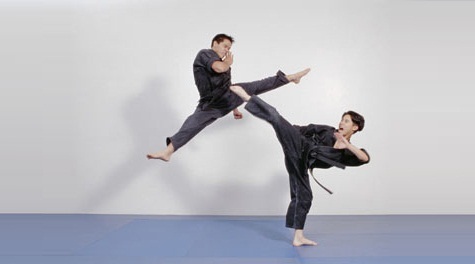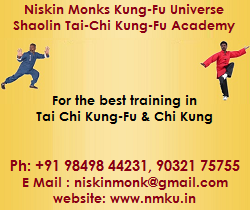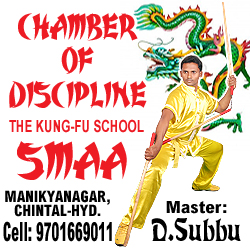
Kung-Fu uses the study of energy flow in the body to increase the students overall physical understanding and level of health. The kung-fu practitioner or student builds the body from the inside out so the body is developed as a whole and is taught to operate as a unitary tool.
If you are looking for the ultimate holistic physical development program, a method that you can study, train and improve over the course of a lifetime Kung-Fu has the path for you.
Kung fu is thousands of years old, but it still offers benefits to modern practitioners. Developed in ancient China to empower poor people who couldn't afford weapons, kung fu uses the entire body, building flexibility, strength, endurance and speed. If you want to improve your mental discipline, increase your physical fitness or gain self-defense skills, kung fu training might be good for you.
Self-Defense
Self-defense is the central goal of kung fu. Practitioners learn to use their whole body to defend and attack. Beginners learn the basic forms of effective punches, kicks and blocks. Advanced students learn complicated combinations and difficult maneuvers, such as high kicks and grapples. The exact techniques you learn depend on the school you attend, but the effect is the same: Once you reach the higher levels of training, you will have the ability to defend yourself in dangerous situations, including attacks by multiple people and armed assailants.
Physical Benefits
While any disciplined exercise regimen will increase your fitness to some degree, kung fu offers a special focus on overall balance, strength and coordination, which will maximize your natural fighting abilities and lead to improved fitness. Kung fu training exercises your whole body. Punches and blocks develop the muscles in your upper body. Kicks develop your lower-body power. Practicing defensive and offensive combinations will develop your coordination. Over time, all these physical training elements combine to give you fast reflexes and heightened fitness.
Mental Benefits
Some people worry that martial arts training makes people violent. But self-control is a key tenet of kung fu and many other martial arts styles. Students learn to ward off negative emotions, such as anger and frustration, by using concentration techniques that rely on repetitive, controlled body movements. The mental benefits of kung fu training include increased focus, discipline, confidence and self-esteem. Kung fu training takes many years, and students must demonstrate personal growth to increase their ranking, so kung fu also encourages patience and hard work.
Methods of training
Forms - The solo repetitive practice and performance of preset fixed sequence of movements that teach and refine specific concepts, principles and techniques. There are two general types of forms in Chinese martial arts. Most common are solo forms performed by a single student. There are also sparring forms—choreographed fighting sets performed by two or more people. Sparring forms were designed both to acquaint beginning fighters with basic measures and concepts of combat, and to serve as performance pieces for the school. Weapons-based sparring forms are especially useful for teaching students the extension, range, and technique required to manage a weapon.
Application Drills - The constant repetition of individual techniques with a training partner will build up confidence and understanding of the position, teach structure and energy usage of each technique, use trapping sets, two person flow drills, and focus mitt training. Chinese martial arts techniques are ideally based on efficiency and effectiveness. Application includes non-compliant drills, such as Pushing Hands in many internal martial arts, and sparring, which occurs within a variety of contact levels and rule sets.
Flow Drills - Touch Drilling is a unique interactive training method that develops structural awareness, correct energy utilization, distance judgment and sensitivity so that you can learn to feel what is happening, assess the situation and react accordingly. It develops close range distance coordination, mobility, balance, timing, accuracy and the correct use of energy.
Qigong (Chi Kung) - Qigong training strengthens the body and unblocks the flow of energy or chi. Students begin with basic standing Chi Kung, a series of soft qigong forms, very similar to yoga, this set was one of the four original forms created by Bodhidharma to help rejuvenate the Shaolin monks after hours of seated meditation. Its stances are similar to yoga. Although not as active as Kung Fu it strengthens the body internally and externally. Qigong literally "Life Energy Cultivation", is a practice of aligning breath, movement, and awareness for exercise, healing, and meditation. With roots in Chinese medicine, martial arts, and philosophy, qigong is traditionally viewed as a practice to cultivate and balance qi (chi) or what has been translated as "intrinsic life energy". Typically a Qigong practice involves rhythmic breathing coordinated with slow stylized repetition of fluid movement, a calm mindful state, and visualization of guiding qi through the body.
Stance Training - Stances are structural postures employed in Chinese martial arts training. They represent the foundation and the form of a fighter's base. Each style has different names and variations for each stance. Stances may be differentiated by foot position, weight distribution, body alignment, etc. Stance training can be practiced statically, the goal of which is to maintain the structure of the stance through a set time period, or dynamically, in which case a series of movements is performed repeatedly. The Horse stance and the bow stance are examples of stances found in many styles of Chinese martial arts.
Weapons training - Most Chinese styles also make use of training in the broad arsenal of Chinese weapons for conditioning the body as well as coordination and strategy drills. Weapons training are generally carried out after the student is proficient in the basics, forms and applications training. The basic theory for weapons training is to consider the weapon as an extension of the body. It has the same requirements for footwork and body coordination as the basics. The process of weapon training proceeds with forms, forms with partners and then applications.
Mr Babu Rao : Black Belt 5th Dan in Kung-fu, 3rd Star in Tai-Chi
Often, when we only see our instructors in class, it's hard to really get to know them on a personal level. We learn that they're great fighters, that they're strong role models, disciplined and hardworking, but beyond that, Mr Babu Rao is virtually a life long martial artist. He has studied numerous fighting systems tutored by some of the most renowned martial artists, starting at an early age. He has earned countless titles throughout the country, combining constant study, work, and commitment to be one of the best.
Babu Rao continues to instruct his students on the seven traditional values: courage, justice, generosity, politeness, honor, honesty, and loyalty. In his class he sweats just as hard as his students. He believes each class is not just about training for fitness or self-defense, but about training for life.
A man with a fiery passion for martial arts, Babu Rao has passion that has led him into different fields of martial arts, and he has achieved much in almost every field he has explored. He strongly believes that Martial Arts is a vehicle for personal growth. He have been teaching martial arts to both children and adults for many years now..
Martial Arts Background
1988: Joined Karate
Learned Karate Katas (movements), Sparring,
1995: Achieved Black Belt
1995: Joined Kung-Fu
Learned: Katas, Animal Kung-Fu
Animal Styles:
Eagle, Snake, Monkey, Leopard, Tiger & Dragon
Weapon Styles:
3ft, 6ft & 9ft Stick, Knife, Dagger, Double Moon, Sun & Moon, Tomfa, long Chuk’s Knife.
1999: Achieved Black Belt In Kung-Fu
2000: 1st Dan In kung-fu
2001: 2nd Dan In kung-fu
2003: 3rd Dan In kung-fu
2000: Started Learning Tai-Chi
Basic Exercise, Short Form, Long Form & Formations
2004: First Star in Tai-Chi
2005: Second Star in Tai-Chi
2006: Third Star in Tai-Chi
1999 – Present: Started as a trainer for Karate, Kung-Fu, Tai-Chi & Self Defense.
Achievements Track
1992: Won Gold Medal for sparring in state level championship.
1993: Okhinova Marital Arts 2nd Prize
1993: Won Gold Medal for katas in state level championship.
1994: Okhinova Martial Arts Katas Gold Medlist
1995: Okhinova Sparring State level Champion Ship Gold Medal
And Many more……….
Committees
1998: Shotokan National Committee
2006 to Till Date : AP All Style Martial Joint Secretary (State Wide)
2007: International Committee Of Bodokan
2008: Asian Continental Bodokan
Head Coach
2008: Given Training For Vijayawada Police Department
2008: Given Training For Railway Athletes (Tai-Chi)
2008: Given Training For ARMY 125TA Battalion for the art of Kung-Fu
2009: Given Training For ADP India Corporation Ltd for the art of self defense
2009: Given Training For D & Shaw Company Ltd.
On Going Classes:
The Reqelford International School , Rampally.
St. Peters Model School, Nacharam.
St Anthony's High School, Himayat Nagar.
Kennedy High The Global School, Miyapur.
Guntur Vikas School, Miyapur.
Oasis School of Execllence, Shamshabad.
Open Classes for all in Sec’bad YMAC, Ecil X Roads, Uppal, Thirumalgiri & Lallapet.
National & International
International Organizing Secretary for all martial arts National Level Referee (1999-Present) at
Vizag, Bombay, Hyderabad, Chennai, Kerala & Karnataka. He is also organizing state level championship from 2004 till now.
Niskin Monks Kung-Fu Universe
Shaolin Tai-Chi Kung-Fu Academy
Contact :+91 98498 44231
Email : niskinmonk@gmail.com
Please visit : http://www.nmku.in




